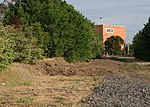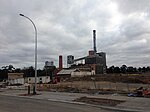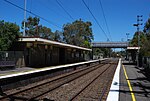Fulham Grange railway station
Disused railway stations in MelbourneRailway stations closed in 1893Railway stations in Australia opened in 1891Use Australian English from February 2015

Fulham Grange was a railway station on the Outer Circle located in the suburb of Alphington, Melbourne, Australia. Located near the Grange and Heidelberg Road intersection, it was a quarter mile (0.4 km) from Fairfield Park station. Opened to serve the speculative housing estate after which it was named, it was provided with 2 side platforms, one located on a loop to the north of the main line. The station was opened with the line on 24 March 1891, and closed with it on 12 April 1893. The line through it reopened on 29 July 1919, as part of the APM Siding, closing again in the 1990s.
Excerpt from the Wikipedia article Fulham Grange railway station (License: CC BY-SA 3.0, Authors, Images).Fulham Grange railway station
Grange Road, Melbourne Alphington
Geographical coordinates (GPS) Address Nearby Places Show on map
Geographical coordinates (GPS)
| Latitude | Longitude |
|---|---|
| N -37.7813 ° | E 145.0245 ° |
Address
Grange Road
Grange Road
3078 Melbourne, Alphington
Victoria, Australia
Open on Google Maps








